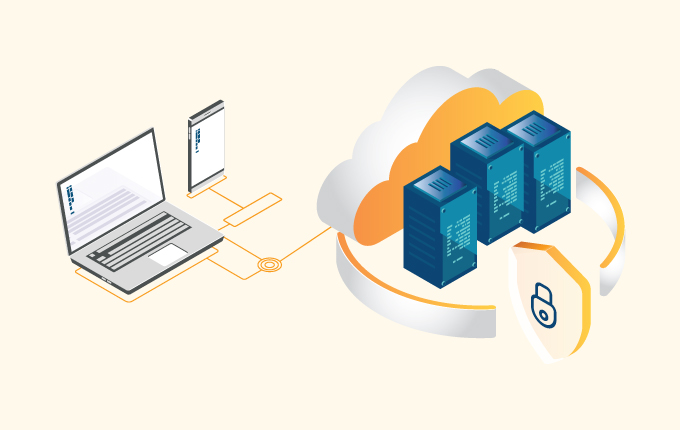[ad_1]
Moving to the cloud? Here’s what you need to know about doing it safely
Moving at least some part of your business to the cloud can potentially make a huge difference to your business.

Cloud adoption brings unparalleled flexibility that allows you to shift how you work on the fly, it gives you the ability to work from anywhere, and it often helps streamline the way you work. One of the biggest challenges with cloud migration, though, is doing it safely.
One wrong step and you can put your entire business, or worse, your customers at risk. But it doesn’t have to be. Let’s take a look at what security challenges you need to consider when migrating the cloud.
Goal setting
The first thing you need to do is decide what your goal is for the process. If you were to just pick up your entire database and network and try to move it to the cloud, it would be a mess. You need to come up with a clear plan that takes into consideration your business goals (both short and long term), as well as the needs of your customers and employees.
Start by thinking about what your immediate needs are. Is there something that your customers are asking for that requires you to be on the cloud? Have your employees been working remotely more and need better access to the tools they use while doing their job? Are there new regulatory requirements coming up that your cloud-based tools can help with?
Questions like these can be a good way to come up with a plan for moving to the cloud. Spend as much time as you need asking questions like this and coming up with a goal for your cloud migration. It saves time, money, and frustration down the road.
Database structure and security analysis
Moving services to the cloud involves migrating data from your servers to the ones located on the cloud (see below).

(source)
You need to make sure that everything you’re moving over to the cloud is going to work the same way it did before to ensure that everything remains consistent. Any changes can potentially affect how something operates, how safe it is, and whether or not something actually works once moved to the cloud.
Completing a security analysis helps you determine what your baseline for security is and helps you better understand what you’re going to need in the cloud because there can be tighter regulations and compliance for data stored in the cloud.
Security challenges when migrating to the cloud
During migration, your data is pretty exposed (even when you’re doing everything right). Imagine you’re walking a hard drive with all your data on it from one building to another building on the other side of town. You’re mostly safe, but there’s also quite a few ways where things can go wrong and your data becomes exposed. Let’s explore these challenges.
- Data Exposure, loss, and external attacks. When you’re moving your data, it’s pretty much out there in the open. You risk losing it or, worse, it could come under attack from cybercriminals. Your security efforts have to be dialed up to their max settings during this to ensure that nothing gets lost or stolen.
- Misconfiguration and human error. Data migrations are complex and it shouldn’t be surprising that if you’re not 100% sure of every setting and process, you risk doing something wrong. A misconfiguration could easily lead to data loss, exposure, or theft.
- Lack of internal resources. Cybersecurity professionals can be hard to come by these days and if you don’t have the knowledge you need in-house, it can impact your cloud migration efforts. Make sure that you’ve either got the skills you need in your shop during the migration or that you’re working with a team who can make it happen.
- Unintended regulatory compliance violations. We hinted at this above, but when you move to the cloud compliance changes because you’re no longer storing your data in an on-prem environment. If you’re not careful, you unintentionally violate regulatory requirements, opening you up to fines and penalties.
- Migrating everything at once. Another one we hinted at above, moving everything over to the cloud at once never ends well. If you don’t move slowly and carefully and ensure that everything you’re trying to move over to the cloud is going into a system designed to support it, it’s going to fail. Part of the reason this happens is that not everything operates the same way in the cloud. If you try and move all your applications over in a lift and shift style situation, you’re going to find that at least one application isn’t going to work properly or worse, that it’s configured in a way that leaves your data exposed. It’s far more expensive and time-consuming to retroactively fix a problem like that, than it would be to move slowly and make sure that you’re doing it right the first time.
Measures to protect your data during migration
To prevent any of the above from happening, you need to be careful and thorough during your entire migration process. The earlier you start your migration plans, the better.
Establish a security baseline before migration
You should always be assessing your security, as it is, but when you’re moving to the cloud you need to know exactly what your baseline requirements are, so you can recreate (or modify) them in the cloud. This means taking a thorough look at everything. Who your users are, what kinds of permissions they have, what your regulatory and compliance needs are, as well as the specific needs of your industry and customers. All of that needs to be recreated after the migration, so capture and document all of it.
Apply the right security during the migration phase
The migration phase is the time when your data is the most exposed because it’s actively being moved from one place to another. This is when it’s best to work with professionals who have done this before because they have the proper tools and the security that goes along with it at their disposal.
If you’re doing it yourself make sure you’re using things like current firewalls, web application firewalls, and a cloud access security broker, among other things. Encryption is critical during this stage, as well, as is making sure that your data isn’t being moved using unsecured APIs.
Make sure you’re compliant
Most cloud tools have compliance baked right in with things like PCI-DSS, GDPR, and HIPAA, but you should audit everything prior to migration to ensure that every regulation that you’re bound by is covered. If something happens and you’ve missed something, not only are you going to get nailed by regulators, but your customers aren’t going to trust you as much.
Proper Monitoring
Monitoring the entire process can make the whole migration process safer for you, your business, and your customers. When you proactively monitor the transfer, you’ll know the moment something happens and can get ahead of any problems that might arise. This could be security issues, but could also include any technical issues that arise from misconfiguration or human error. The sooner you catch these problems, the less likely you are to have a huge problem.
Backup before Migration
This should go without saying, but always back up before you attempt something like this. A good backup strategy prevents small problems from becoming big ones. And, if something does go wrong, you can easily delete and start again, rather than trying to sort through the problem and come up with a complex solution.
Phased Migration
We’re going to keep saying this, but never move everything all at once. Ever. Migrate in stages to prevent major security issues, expensive problems, and downtime.
Get help with your migration
The safest way to migrate your business to the cloud is with the help of an MSP, like us. We have decades of experience ensuring that businesses keep their data safe and are experts at cloud migration.
To find out more about how we can help you complete the safest migration possible, contact us today.
The post Security challenges while migrating to the cloud appeared first on Manhattan Tech Support.
[ad_2]


